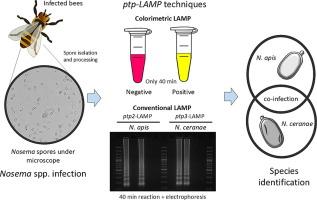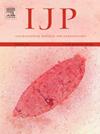Development of a ptp2-LAMP assay for the specific and sensitive detection of Nosema apis and its comparison with ptp3-LAMP for the detection of Nosema ceranae, in a region endemic for both microsporidium pathogens of the Western honey bee
IF 3.2
2区 医学
Q1 PARASITOLOGY
引用次数: 0
Abstract
The Western honey bee plays a pivotal role in global food security as the primary commercial pollinator. The microsporidian pathogens Nosema apis and Nosema ceranae infect the bee midgut, causing nosemosis, a debilitating infectious disease that results in considerable economic losses in apiculture. Traditionally, Nosema spp. infection is diagnosed by microscopic detection and quantification of spores. However, only molecular diagnostics allow differentiation between N. apis and N. ceranae. Loop-mediated isothermal amplification (LAMP) is a rapid, highly specific, and sensitive DNA detection method. The present study aimed to develop a LAMP protocol for N. apis based on the species-specific single copy polar tube protein 2 (ptp2) gene, and to analyze and compare its diagnostic performance with the previously developed polar tube protein 3 (ptp3) gene-based LAMP protocol for N. ceranae. The ptp2- and ptp3-LAMP assays specifically identified N. apis and N. ceranae, respectively. Their analytical sensitivity was tested using serial dilutions of plasmid and genomic DNA, demonstrating that ptp2- and ptp3-LAMP consistently detected down to 103 ptp2 and 104 ptp3-gene copies, respectively. Amplification was verified by agarose gel electrophoresis (conventional format), and by a change from pink to yellow color after addition of a suitable dye (colorimetric format). The ptp2- and ptp3-LAMP assays and a reference duplex PCR were applied to a panel of field samples (n = 55) from a region endemic for both Nosema spp. Conventional and colorimetric ptp2-LAMP showed an almost perfect test agreement (kappa value > 0.81) compared with duplex PCR. Conventional and colorimetric ptp3-LAMP assays showed a substantial (kappa value > 0.60) and almost perfect test agreement (kappa value > 0.81), respectively. The ptp2- and ptp3-LAMP assays provide excellent performance, ease of implementation, cost savings, and rapid execution, making them ideal choices for molecular detection and differentiation of N. apis and N. ceranae.

在西部蜜蜂两种微孢子虫病原体流行的地区,建立了一种特异性和敏感性检测api微孢子虫的ptp2-LAMP方法,并与ptp3-LAMP检测ceranae微孢子虫的比较。
西方蜜蜂作为主要的商业传粉媒介,在全球粮食安全中发挥着关键作用。微孢子虫病原体apis微孢子虫和ceranae微孢子虫感染蜜蜂中肠,引起鼻塞病,这是一种使人衰弱的传染病,给养蜂业造成相当大的经济损失。传统上,小孢子虫感染是通过显微镜检测和孢子定量诊断的。然而,只有分子诊断才能区分apis和ceranae。环介导等温扩增(LAMP)是一种快速、高特异性和敏感的DNA检测方法。本研究旨在建立一种基于物种特异性的单拷贝极管蛋白2 (ptp2)基因的LAMP诊断方案,并与已建立的基于极管蛋白3 (ptp3)基因的LAMP诊断方案进行比较分析。ptp2-和ptp3-LAMP分别特异性鉴定了apis和ceranae。通过质粒和基因组DNA的连续稀释测试了它们的分析灵敏度,证明ptp2-和ptp3-LAMP分别能够检测到103ptp2和104ptp3基因拷贝。通过琼脂糖凝胶电泳(常规格式)验证扩增,并通过添加合适的染料后从粉红色变为黄色(比色格式)验证扩增。将ptp2-和ptp3-LAMP检测方法以及参考双链PCR方法应用于一组来自小孢子虫流行地区的现场样本(n = 55)。与双链PCR相比,常规和比色ptp2- lamp检测结果几乎完全一致(kappa值> 0.81)。常规和比色ptp3-LAMP检测分别显示了相当的(kappa值>.60)和几乎完美的检测一致性(kappa值>.81)。ptp2-和ptp3-LAMP检测具有优异的性能,易于实施,节省成本和快速执行,使其成为api和ceranae分子检测和分化的理想选择。
本文章由计算机程序翻译,如有差异,请以英文原文为准。
求助全文
约1分钟内获得全文
求助全文
来源期刊
CiteScore
8.40
自引率
2.50%
发文量
76
审稿时长
23 days
期刊介绍:
International Journal for Parasitology offers authors the option to sponsor nonsubscriber access to their articles on Elsevier electronic publishing platforms. For more information please view our Sponsored Articles page. The International Journal for Parasitology publishes the results of original research in all aspects of basic and applied parasitology, including all the fields covered by its Specialist Editors, and ranging from parasites and host-parasite relationships of intrinsic biological interest to those of social and economic importance in human and veterinary medicine and agriculture.

 求助内容:
求助内容: 应助结果提醒方式:
应助结果提醒方式:


